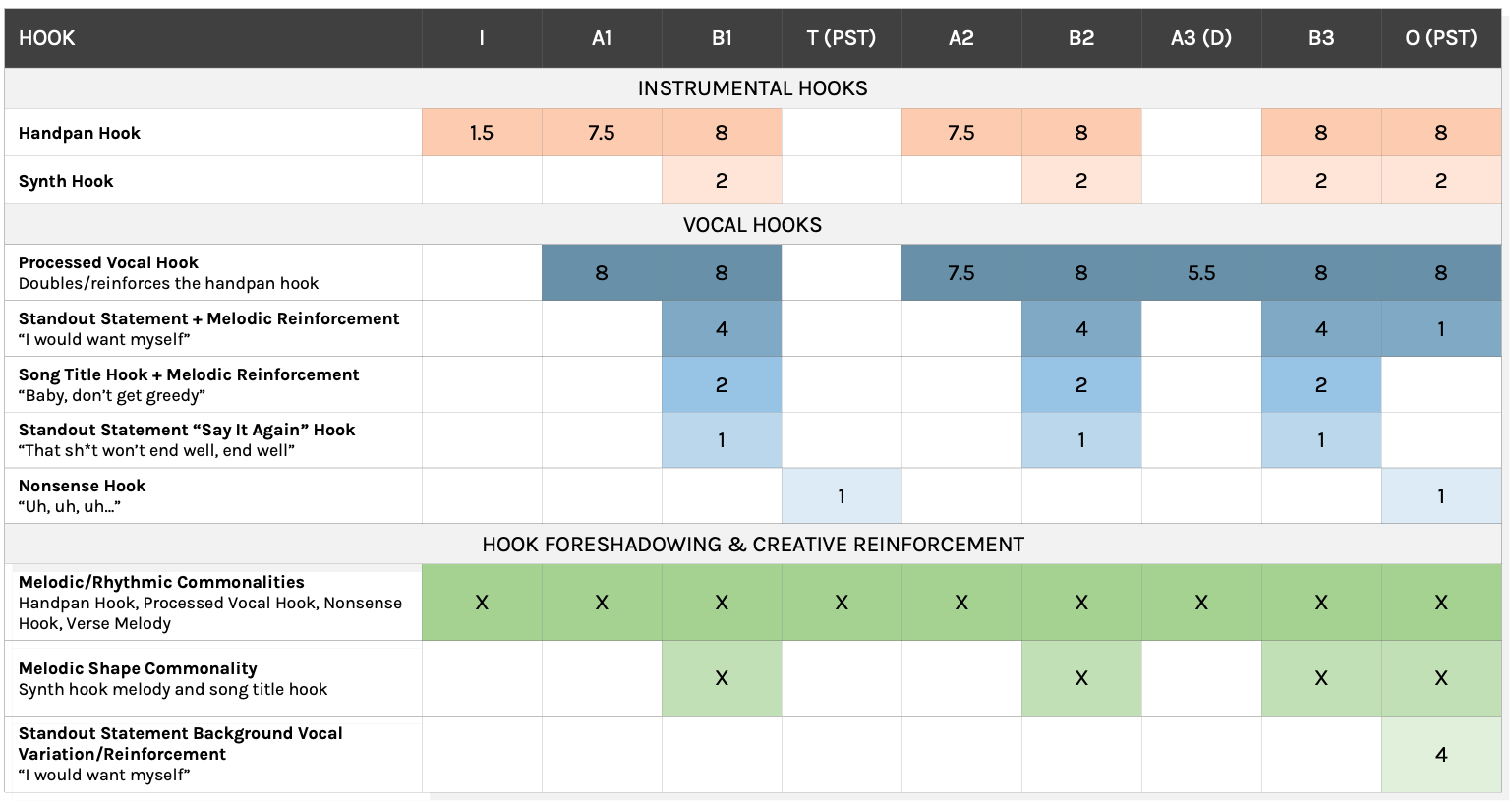What’s the secret behind “greedy’s” meteoric rise to the upper echelon of charts worldwide? It all comes down to the song’s abundance of irresistibly catchy and strategically arranged hooks!
McRae and her team of hitmaker collaborators including Amy Allen, Jasper Harris, and Ryan Tedder, masterfully transformed simple, easy-to-connect melodies into standout hooks using tried-and-true “hook dressing” techniques. These techniques include leveraging the song title; incorporating two standout statements; infusing fun, nonsense lyrics, employing repetition (the HSD “say it again” technique), and integrating unique timbres.
In addition to their skillful deployment, the song’s catchiness and memorability are heightened further through clever hook foreshadowing and creative reinforcement techniques, ensuring that “greedy” not only leaves a lasting impression but also avoids overstaying its welcome.
What follows is an inside look at “greedy’s” masterful hook arrangement, from intro to outro.
“greedy’s” Hook Arrangement

Sectional Progression #1: Intro (I), Verse 1 (A1), Chorus 1 (B1)
Intro
In the opening moments of “greedy,” the initial hook that catches the listener’s ear features a percussive, pitched, steel drum timbre. The hook’s simplicity and unique quality not only draws the listener in from the very start but also serves as an instantly recognizable calling card for the song. As soon as one hears it, they know exactly what song it is.
Verse 1
However, there’s more to the steel drum hook than what initially meets the ear. It cleverly plays a dual role by foreshadowing and subsequently reinforcing elements of the verse melody, where it’s featured in tandem with McRae’s lead and complementing low-level processed vocal. This clever technique makes it easier for the first installment of the narrative to connect while keeping the hook melody in the listener’s ear.
Chorus 1
With the steel drum hook acting as a consistent thread across sections, the ensuing chorus presents not one, not two, but three new vocal hooks. The first is the bold, standout statement “I would want myself,” which is primely placed at the top of the section. Serving as the song’s primary vocal hook with its egocentric, empowering quality, it is subsequently reinforced melodically on every other line but with different lyrics, striking an effective balance of freshness and familiarity.
The second line in the chorus, “baby, please believe me,” may seem lyrically unremarkable, yet it plays a vital role in melodically and rhymingly foreshadowing the song title hook, “baby, don’t get greedy,” which emerges later in line 6. Complementing this is the newly added synth “nano hook,” which provides the section with a catchy, atmospheric embellishment, and foreshadows and subsequently reinforces the song title hook’s melodic shape.
Lastly, the chorus concludes with the lyric, “that sh*t won’t end well, end well,” another standout statement that employs the commonly used “say it again” repetitive “hook dressing” technique, as Hit Songs Deconstructed calls it.
In summary, the chorus is a bonified hook fest, strategically introducing and reinforcing hooks as it progresses to ensure that the song’s primary “hook center” gets firmly ingrained in the listener’s head.
Sectional Progression #2: Turnaround Post-Chorus (T PST), Verse 2 (A2), Chorus 2 (B2)
Turnaround
Following the super-catchy, dense, and energetic chorus, a brief one-bar turnaround with a breakdown arrangement is employed to bring things back down, give the listener a breather, and provide room for the song to build once again. However, it also uniquely features a new nonsense vocal that cleverly reinforces the steel drum hook melody and aspects of the verse 1 vocal while simultaneously foreshadowing McRae’s verse 2 vocal.
Verse 2 & Chorus 2
The subsequent verse 2 and chorus 2 sections feature the same hook structures as their first occurrence counterparts, fostering familiarity within the song. Balancing this are verse lyrical developments and instrumental variations, which serve to heighten interest as the song progresses.
Sectional Progression #3: Verse 3 (A3), Chorus 3 (B3), Outro Post-Chorus (O PST)
Verse 3
The third and final sectional progression in “greedy” begins with verse 3, serving as the song’s primary “D” (departure) section in lieu of a more conventional bridge (it features the same core vocal melody as the other verse sections but with differentiated accompaniment and lyrics). In contrast to the other verses, the processed vocal hook reinforces aspects of McRae’s vocals as opposed to the familiar steel drum hook, which plays a differentiated pattern. This strategic decision was warranted to both heighten the impact of the departure while preventing the familiar steel drum hook from becoming overly redundant in the scope of the song.
Chorus 3 and Outro
The ensuing chorus revisits the familiar hook structure of its earlier counterparts, a best practice that ensures it fully connects, resonates, and is remembered. The outro then follows with a unique, yet familiar, hook pairing, known as the Hit Songs Deconstructed “Grand Finale Hook Fest” technique.
With the steel drum hook providing familiar accompaniment, the chorus standout statement, “I would want myself,” is cleverly echoed as a background vocal. Compared to the chorus, it is uniquely delivered with a rhythmically displaced approach that traverses the stereo field, providing the outro with additional production ear candy as it is further reinforced with the listener. Midway through the section, a single instance of the proper “I would want myself” vocal resurfaces, further reinforcing its presence and enhancing engagement within the otherwise repetitive section.
The final hook heard in “Greedy” is the nonsensical “uh” hook, initially introduced during the brief turnaround. In the outro, it stands alone without any accompaniment, emphasizing its distinctiveness and connection with the listener. The hook cuts off abruptly at the tail end of the song, leaving the listener with a sense of anticipation and most notably, a likely longing for more.
View this technique in the techniques library here.